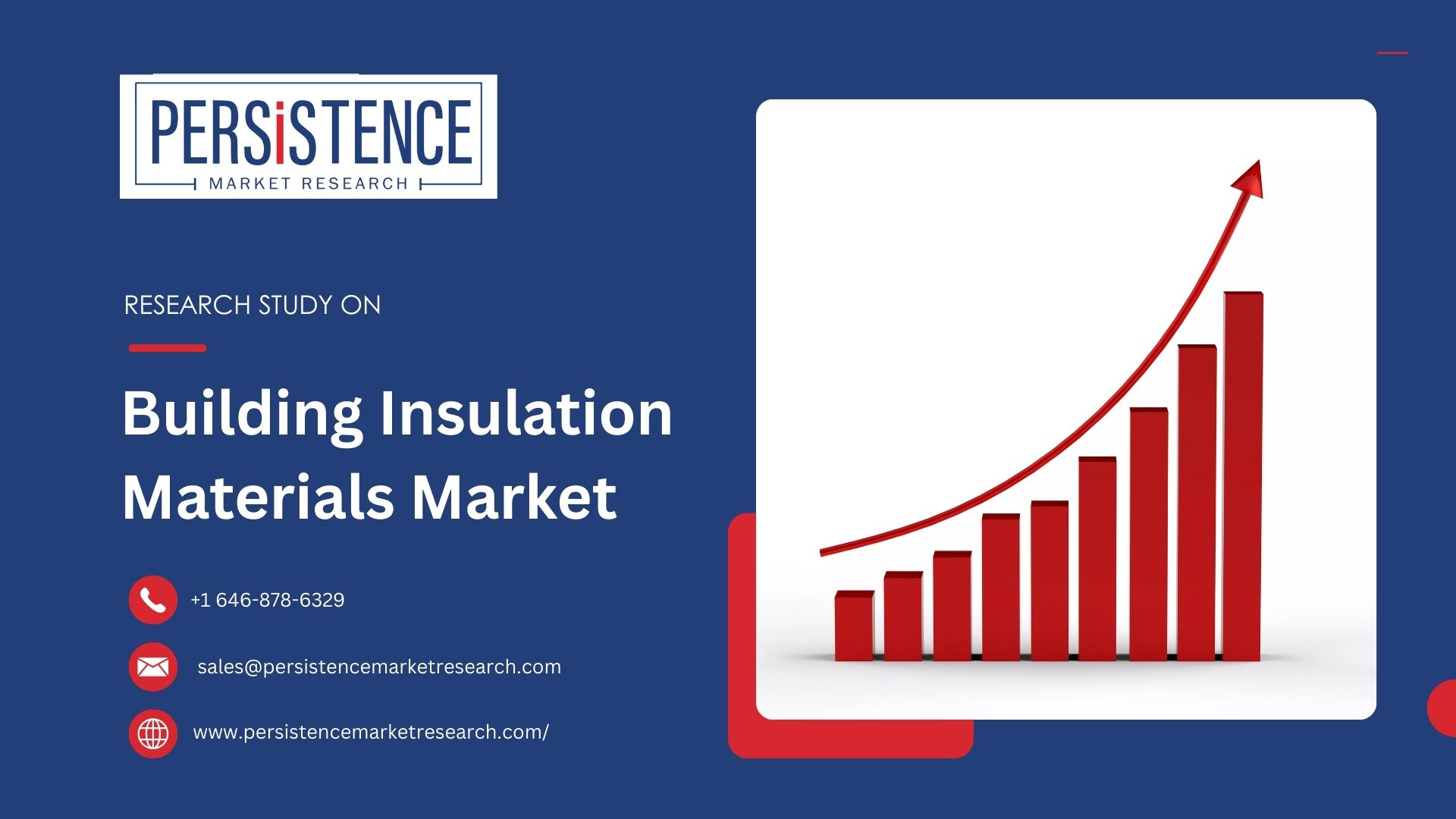Top 10 Trends in the Global Building Insulation Market (2025–2032)

Strong 8k brings an ultra-HD IPTV experience to your living room and your pocket.
The global building insulation market is undergoing a significant transformation, driven by increasing energy efficiency standards, environmental concerns, and technological advancements. The construction and real estate industries are rapidly adopting insulation materials to comply with building regulations, improve energy conservation, and meet sustainability goals. According to Persistence Market Research's projections, the global building insulation materials market is estimated to reach a size of US$ 33.0 billion by 2025, and it is predicted to expand at a CAGR of 5.7% through the assessment period, reaching a value of US$ 48.6 billion by 2032. This growth is being fueled by key market trends that are reshaping the industry.
In this blog, we’ll explore the top 10 trends in the building insulation market from 2025 to 2032. These trends will be critical for companies, stakeholders, and investors seeking to navigate this dynamic sector.
1. Sustainability and Eco-Friendly Materials
As global awareness of climate change and environmental sustainability continues to rise, the demand for eco-friendly insulation materials is also growing. Construction companies and consumers alike are now prioritizing environmentally responsible products. Insulation materials that are made from recycled or renewable sources, such as cellulose, cotton, and sheep wool, are gaining significant traction in the market.
Key Drivers:
- Government incentives for sustainable construction practices
- Rising consumer preference for green buildings
- Efforts to meet green certifications like LEED and BREEAM
Eco-friendly materials not only help reduce energy consumption but also contribute to minimizing carbon footprints, making them a major trend in the coming years.
2. Technological Advancements in Insulation Materials
The ongoing development of advanced insulation technologies is one of the most exciting trends in the building insulation market. Aerogel insulation, for example, is becoming increasingly popular due to its extremely low thermal conductivity and lightweight properties. In addition, the emergence of smart insulation that can adapt to temperature changes and optimize energy consumption is another breakthrough driving innovation.
Key Drivers:
- Ongoing R&D in nanomaterials and aerogels
- Increasing adoption of smart home technologies that incorporate energy-efficient materials
- Advancements in spray foam and polyurethane insulation
These technological advancements enable construction projects to achieve higher levels of energy efficiency, which is crucial for achieving sustainability goals.
3. Energy-Efficient Buildings
As global energy consumption continues to rise, there is an increasing emphasis on reducing energy demand through better building designs. Insulation plays a crucial role in enhancing the energy efficiency of buildings by reducing heat loss in the winter and minimizing heat gain in the summer. Energy-efficient buildings are no longer just a trend; they are quickly becoming the standard for new construction projects.
Key Drivers:
- Rising energy prices
- Stringent government energy-efficiency regulations
- The global shift towards net-zero energy buildings
Building owners are now seeking ways to reduce heating and cooling costs, and insulation materials offer an affordable solution to achieve this goal.
4. Rise of High-Performance Insulation Solutions
High-performance insulation solutions are increasingly in demand, particularly for buildings that require extreme levels of insulation due to environmental factors or building use. These materials are designed to meet strict energy-efficiency standards while providing superior thermal and acoustic insulation.
Key Drivers:
- Increasing adoption of high-performance building standards
- Advancements in insulation materials such as polyisocyanurate foam and graphite-enhanced insulation
- The need for buildings to comply with stricter regulations on energy use and emissions
High-performance insulation solutions are crucial for achieving top-tier energy-efficiency ratings and are expected to see continued growth.
5. Use of Recycled and Waste Materials
Recycled materials and waste products are increasingly being incorporated into building insulation materials. For example, recycled denim and wool are now being used as sustainable insulation options. Additionally, recycled glass and plastic are also being processed to create more affordable and environmentally friendly insulation solutions.
Key Drivers:
- The growing focus on circular economy principles
- Rising awareness about reducing waste and promoting recycling
- Cost-effectiveness and availability of recycled materials
This trend helps reduce the overall environmental impact of building construction and supports the development of sustainable building practices.
6. Government Regulations and Policies
Governments worldwide are enacting stricter building codes and energy-efficiency regulations to address rising energy consumption and reduce greenhouse gas emissions. This is one of the primary drivers of the insulation market’s growth. These policies mandate the use of high-quality, energy-efficient insulation materials in new buildings and renovations.
Key Drivers:
- Stricter building codes and energy performance regulations
- Incentives and tax rebates for using energy-efficient materials
- Global push for carbon-neutral buildings
As energy efficiency becomes a legal requirement, the demand for advanced insulation materials will continue to surge.
7. Urbanization and Increasing Construction Activity
The global trend of urbanization, particularly in emerging markets, is leading to a surge in construction activity. As cities expand and populations increase, the demand for new residential, commercial, and industrial buildings rises. With this growth comes the increased need for effective insulation to ensure energy efficiency and comfort in urban buildings.
Key Drivers:
- Growing urban population in emerging markets
- Increased construction projects due to economic development
- Heightened demand for energy-efficient buildings in urban areas
This trend will drive the adoption of insulation solutions in new buildings, particularly in urban centers.
8. Fire-Resistant Insulation Materials
As fire safety becomes an ever-increasing concern in building design, fire-resistant insulation materials are gaining traction. These materials are essential for reducing the spread of fire and improving the safety of residents, workers, and occupants in commercial and residential buildings.
Key Drivers:
- Stringent fire safety codes and regulations
- Increased awareness of fire risks in high-rise buildings
- Rising demand for fireproof insulation in public buildings, schools, and hospitals
Materials such as mineral wool, fiberglass, and ceramic fiber are some of the top fire-resistant insulation solutions being adopted in the market.
9. Increasing Adoption of Spray Foam Insulation
Spray foam insulation is gaining widespread popularity due to its versatility, ease of application, and superior air-sealing properties. It can be used in a variety of applications, from wall and attic insulation to irregularly shaped spaces, offering a seamless solution that is both energy-efficient and effective in minimizing air leaks.
Key Drivers:
- Superior air-sealing properties
- Growth in residential and commercial retrofitting projects
- High demand for customized insulation solutions
Spray foam insulation’s ability to fill small gaps and hard-to-reach areas makes it an ideal choice for both new constructions and renovations.
10. Focus on Indoor Air Quality (IAQ)
Indoor air quality (IAQ) is becoming an increasingly important consideration for building owners and tenants. The materials used in insulation can impact IAQ by either reducing or contributing to indoor pollution. Manufacturers are now developing insulation products that improve IAQ by being free from volatile organic compounds (VOCs) and other harmful chemicals.
Key Drivers:
- Rising concern about health and well-being in indoor spaces
- Demand for low-VOC and non-toxic insulation options
- Increased focus on IAQ due to COVID-19 and the subsequent rise in home-office environments
Consumers are now more aware of the potential risks of indoor pollutants, leading to a growing demand for insulation materials that promote a healthier living environment.
Conclusion
The global building insulation materials market is poised for substantial growth between 2025 and 2032. As energy efficiency, sustainability, and safety continue to be major focal points for the construction industry, insulation materials are evolving to meet these demands. Persistence Market Research’s projections indicate that the market will reach a size of US$ 33.0 billion by 2025, with an anticipated growth rate of 5.7% CAGR, reaching US$ 48.6 billion by 2032. These top 10 trends will play a crucial role in shaping the future of the market, offering vast opportunities for manufacturers, developers, and consumers to create more efficient, sustainable, and safe buildings.
The evolving building insulation landscape presents exciting possibilities for stakeholders to explore new technologies, eco-friendly solutions, and innovative materials, while adhering to stricter regulations and enhancing performance standards. With these trends, the insulation market is not just responding to current needs—it is actively driving the future of energy-efficient construction.
Note: IndiBlogHub features both user-submitted and editorial content. We do not verify third-party contributions. Read our Disclaimer and Privacy Policyfor details.


